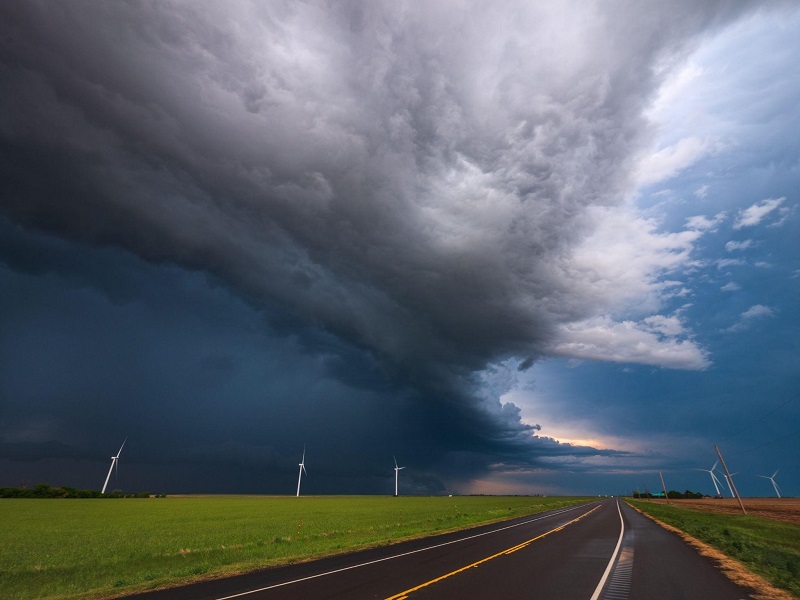How To Prevent Storm Damage in Texas

There are many opinions on climate change. Various points to be made, different systems of belief, and so on. But make no doubt about it, Texans are going to face hazardous weather one way or another. Storm damage can come in many forms and in the Lone Star State, variety is in no short supply. This is why of all of the U.S. states most prone to natural disasters, Texas continues to come out on top. Learn more about Texas storm damage, how to mitigate it, and how to protect yourself from a wide range of weather-related perils.
Common Causes of TX Storm Damage
The most common sources of storm damage for residents of Texas come from wind and hail damage. Texas storm damage claims come from these sources more than any other type of damage. This is because no matter where you live in Texas, you’re likely going to run into this threat.
Despite being home to an estimated 200 volcanoes, you’re probably not going to have to deal with this weather event as they are inactive. Otherwise, Texans will find themselves at risk from several extreme weather patterns. Here are the most common threats:
Windstorms and Hail
Except for Amarillo, Texas, windstorms, and hail can be somewhat common occurrences throughout the entire state. From storm damage in North Texas caused by tornadoes to the intense tropical storms and hurricanes of the Gulf Coast, everyone has this threat.
Central Texas, as well as other portions, suffer from severe thunderstorms that can cause hail, produce tornadoes, and provide gusts of wind that can damage your home, vehicles, and property. Hail is most common in the spring and summer months. Even cities in West Texas are vulnerable to such threats.
Flooding
It’s easy to point to the big events that have caused floodings, such as Hurricane Harvey or the Tax Day Flood of 2016. However, the risk of flooding continues to spread throughout Texas through more routine means, including from severe thunderstorms.
The growing population is creating larger cities and affecting the landscape around us. This is necessary for people to live but helps create flooding in urban areas. Rural areas are also at risk in many cases. A large portion of Central Texas is considered “Flash Flood Alley” which is one of the most flood-prone areas in North America.
Intense weather patterns including rising tides and warming waters are also a concern. Tropical storms and hurricanes can develop with great intensity bringing not only increased wind damage but an outpouring of rain combined with stronger storm surges.
Lightning and Wildfires
Many Texans facing the threat of a tornado path are also susceptible to lightning strikes from severe thunderstorms. These strikes can cause serious damage to your home or property, especially when fires are started.
Speaking of sparks, while not a “storm” per se, wildfires continue to be a problematic weather event. Prolonged periods of drought have created areas vulnerable to wildfires including Central Texas and North Texas. No matter in what form, fires may be the rarest insurance claim for homeowners, but it’s easily the most expensive.
Tips for Preventing Storm Damage to Homes in Texas
Although storm damage can happen in many forms, there are ways to protect your home. Certain home improvements can be a healthy investment in your home to help it withstand more extreme weather events. These are the best ways to protect your home from a Texas storm:
Protect Your Roof
Your roof is one of the most important components of your home. It also protects you from things that are above as well as keeps the structural integrity of your home. This is why home insurance companies are adamant about homeowners maintaining a roof in good condition.
Missing or damaged shingles are a great place to start. These are vulnerable areas that can lead to bigger issues including damage further as a result of hail damage or water damage from rain that leaks inside.
If you’re looking to step things up a notch, installing a roof with a higher grade can also help you resist more storm damage. Metal roofing can provide an increased form of protection from roof damage and even increase the value of your home.
Replace Loose Siding
Loose siding can lead to structural vulnerabilities meaning leaks can occur. You’ll also want to secure loose siding as in high winds it can be launched towards your property causing even more damage.
Storm Grade Windows and Shutters
Having storm-grade windows and shutters on your home can help you protect against objects that can fly into your home and add curb appeal in the process. These are great solutions for homeowners who live in areas prone to windstorms, specifically Texans along the Gulf Coast.
Repair Cracks and Holes
When cracks go unchecked, water and wind have avenues to enter your home. This only intensifies the storm damage your home will face. Caulking around windows, doors, and pipes can help you better insulate your home and protect it against severe weather at the same time.
Routine Maintenance
Beyond making repairs, taking care of your property can protect your home during storms. This means making sure your trees are trimmed, securing loose items around your home before a storm, making sure your gutters are in working order and pointed away from your home, etc.
Elevating Your Foundation
Though it comes with a notable price tag, homeowners who are looking for a worthwhile investment should consider raising the elevation of their homes. By doing so, you can help your home avoid flooding perils from the many weather patterns that may cause it.
Keeping Texas Vehicles Safe From Storm Damage
Just like your home, vehicles need help when it comes to surviving storm damage. Drivers have many options available that can help them avoid a trip to their local body shop for storm damage repair:
Park in a Garage
Parking your vehicle inside of a garage may feel obvious but it’s an important step to cover and remember. If you do not have a garage, you’ll want to park away from potential falling or flying objects such as loose outdoor furniture or away from trees.
Another garage alternative is to park close to your home. This comes with risks, but using your home or another building as a barrier to the wind can protect your vehicle from potential wind-related damages.
Move Your Vehicle
Homes are stationary, but your vehicle can move to higher ground. If extreme weather is on its way and evacuating is an option, for your safety and the good of your vehicle, it can be a great option. Even if you don’t leave, moving your vehicle to higher ground can protect it from flooding.
Car Covers and Hail Blankets
By using such coverings, no matter where you are, you’ll at least have some form of protection. Hail blankets help absorb the blow from many different sizes of hail. Even a thick blanket if you’re in a pinch can help mitigate some of the damage.
Does Car Insurance Cover Storm Damage?
Yes, car insurance will cover you from many types of storm damage, but it depends on the type of policy you have. All drivers in Texas are required to have liability coverage according to state law, but you’ll need comprehensive coverage to protect against damage from storms.
A comprehensive auto insurance policy protects drivers against losses that come from non-accident-related losses. This includes weather-related incidents such as flooding, wildfires, hail, wind damage, fallen tree branches, etc.
Additionally, drivers with full coverage are also protected from storm damage. This is because full coverage is made up of three different coverages including liability, comprehensive, and collision.
Does Homeowners Insurance Cover Storm Damage?
Yes, your homeowners insurance coverage protects against various forms of storm damage, but it’s going to depend on many other factors. Many weather-related perils are covered by a standard home insurance policy but it’s not blanket coverage. Here are some common considerations homeowners should know:
- Windstorm and hail damage are covered by your policy.
- The nature of your damage will come into play when it comes to water damage. If it is caused by an accidental, sudden weather event it’s covered, but not if caused by general wear and tear.
- Speaking of water damage, flood damage isn’t included. Homeowners can still protect against flooding but will need flood insurance to do so.
- Lightning and fire damage are also covered by your home insurance policy.
- The weight of snow, ice, and sleet is also covered should you face damage from a snowstorm. Burst pipes are often covered by a home insurance policy, though it may vary from policy to policy.
A home insurance policy helps you protect your finances by providing reimbursement for storm damage repairs among other perils. This is why we strongly encourage all homeowners to remain covered by home insurance.
Resources Are Available for Texans

After you’ve suffered storm damage, there is still the risk of suffering from further losses by it getting worse over time. This is why it’s important to be prepared with the right resources and knowledge to help mitigate your losses.
You’ll want to document everything that you can for when it’s time to make an insurance claim but you’ll also need to do what you can to fix the damage or protect against the damage expanding or you may find that your claim is not covered.
Besides makeshift repairs before proper professionals can do so, getting in touch with your insurance provider can be very helpful during times like this. The agents at Freedom Insurance Group provide excellent customer service by assisting our clients when they need us the most. Furthermore, the Texas Department of Insurance (TDI) provides plenty of resources for disaster preparation.
Filing a Claim After Suffering From Storm Damage
After the storm filing your claim may feel overwhelming, but it doesn’t have to be. When you use a highly rated insurance provider, you’ll gain a personal touch and assistance through the process.
The basics mean that you’ll need to take down documentation, prevent the damage from getting worse, and contact your insurance agent as soon as possible. This will put you on the fast track to restoring your loss and moving forward.
Since 2005, we’ve provided our clients with personal service all while helping them save an average of 40% on their insurance policies. We help Texans with everything from filing a hail damage insurance claim to finding the best coverages to meet their needs and of course, saving money in the process.
We offer a full range of insurance products through our insurance center that can help you stay better protected from storm damage and much more. You can even bundle your coverages together to save even more. Ask an agent or feel free to use one of our online tools for a no-obligation quote today:






